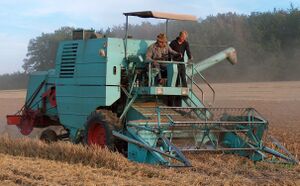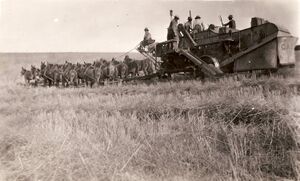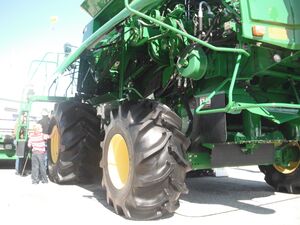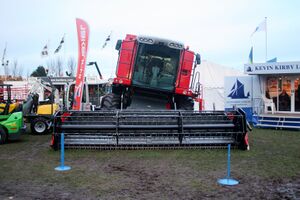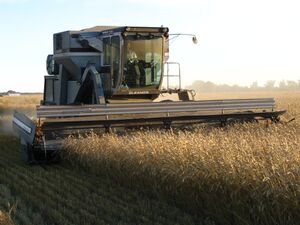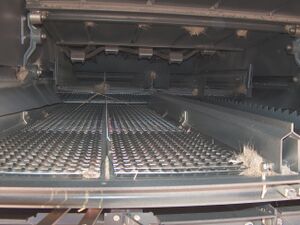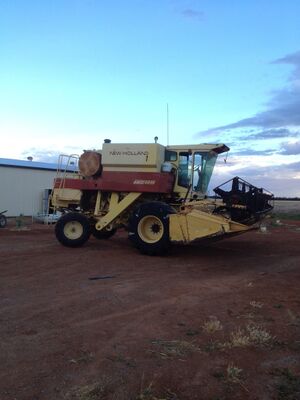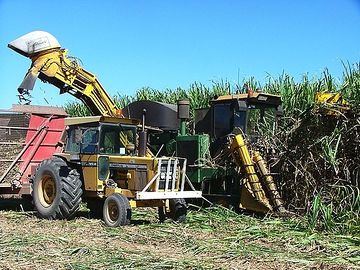حصادة
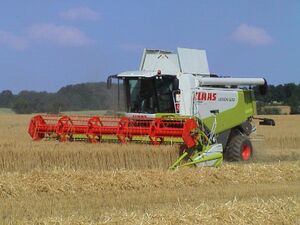
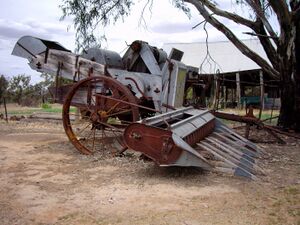
The modern combined harvester, or simply combine, is a versatile machine designed to efficiently harvest a variety of grain crops. The name derives from its combining four separate harvesting operations—reaping, threshing, gathering, and winnowing—into a single process. Among the crops harvested with a combine are wheat, rice, oats, rye, barley, corn (maize), sorghum, soybeans, flax (linseed), sunflowers and canola. The separated straw, left lying on the field, comprises the stems and any remaining leaves of the crop with limited nutrients left in it: the straw is then either chopped, spread on the field and ploughed back in or baled for bedding and limited-feed for livestock.
Combine harvesters are one of the most economically important labour saving inventions, significantly reducing the fraction of the population engaged in agriculture.[1]
التاريخ
In 1826 in Scotland, the inventor Reverend Patrick Bell designed (but did not patent) a reaper machine, which used the scissors principle of plant cutting; a principle that is still used today. The Bell machine was pushed by horses. A few Bell machines were available in the United States. In 1835, in the United States, Hiram Moore built and patented the first combine harvester, which was capable of reaping, threshing and winnowing cereal grain. Early versions were pulled by horse, mule or ox teams.[2] In 1835, Moore built a full-scale version with a length of 5.2 m (17 ft) and a cut width of 4.57 m (15 ft); by 1839, over 20 ha (50 acres) of crops were harvested.[3] This combine harvester was pulled by 20 horses fully handled by farmhands. By 1860, combine harvesters with a cutting, or swathe, width of several metres were used on American farms.[4]
A parallel development in Australia saw the development of the stripper based on the Gallic stripper, by John Ridley and others in South Australia by 1843. The stripper only gathered the heads, leaving the stems in the field.[5] The stripper and later headers had the advantage of fewer moving parts and only collecting heads, requiring less power to operate. Refinements by Hugh Victor McKay produced a commercially successful combine harvester in 1885, the Sunshine Header-Harvester.[6]
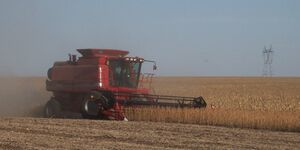
Combines, some of them quite large, were drawn by mule or horse teams and used a bullwheel to provide power. Later, steam power was used, and George Stockton Berry integrated the combine with a steam engine using straw to heat the boiler.[7] At the turn of the twentieth century, horse-drawn combines were starting to be used on the American plains and Idaho (often pulled by teams of twenty or more horses).
الاستواء على سفوح التلال

In the Palouse region of the Pacific Northwest of the United States the combine is retrofitted with a hydraulic hillside leveling system. This allows the combine to harvest the steep but fertile soil in the region. Hillsides can be as steep as a 50% slope. Gleaner, IH and Case IH, John Deere, and others all have made combines with this hillside leveling system, and local machine shops have fabricated them as an aftermarket add-on.
الحفاظ على سرعة الدريس
عملية الدريس
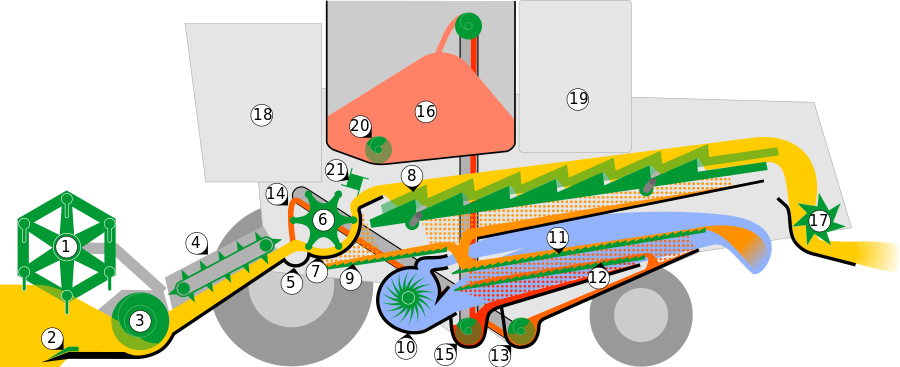
| 1) Reel 2) Cutter bar 3) Header auger 4) Grain conveyor 5) Stone trap 6) Threshing drum 7) Concave 8) Straw walker 9) Grain pan 10) Fan | 11) Top Adjustable sieve 12) Bottom sieve 13) Tailings conveyor 14) Rethreshing of tailings 15) Grain auger 16) Grain tank 17) Straw chopper 18) Driver's cab 19) Engine 20) Unloading auger 21) Impeller |
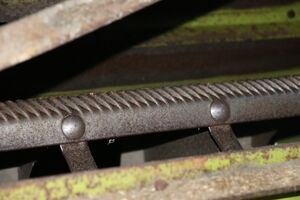
Despite great advances in mechanics and computer control, the basic operation of the combine harvester has remained unchanged almost since it was invented.
التصميمات التقليدية والدوارة
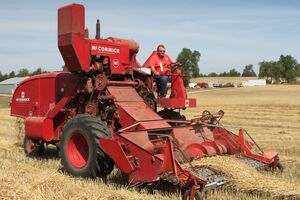
حصادة القصب
حاصدة القصب Sugarcane Combine آلة لحصاد قصب السكر، تقطع القصب وتقذفه على الشاحنات لنقله، وكان الأخوان توفت Toft Bros أصحاب مزارع قصب السكر ـ في منطقة بندابرگ، كوينزلاند بأستراليا ـ قد طورا صناعة هذه الآلة خلال الأربعينيات والخمسينيات من القرن العشرين، وبحلول السبعينيات من القرن العشرين، أصبحت أستراليا أول من حوّل صناعة قصب السكر إلى الميكنة الكاملة. وتعد الشركة التي أسسها الأخوان تفت رائدة في صناعة آلات حصاد قصب السكر.
انظر أيضًا
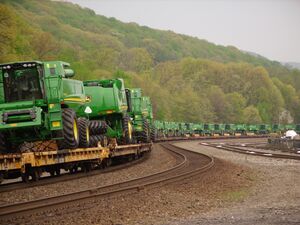
- Agricultural machinery
- Combine Demolition Derby
- Custom harvesting
- Museum of Scottish Country Life Largest collection of Combine Harvesters in Europe.
المراجع
- الهامش
- ^ Constable, George; Somerville, Bob (2003). A Century of Innovation: Twenty Engineering Achievements That Transformed Our Lives, Chapter 7, Agricultural Mechanization. Washington, DC: Joseph Henry Press. ISBN 0-309-08908-5.
- ^ "About Combine harvesters". Mascus UK.
- ^ Biographical Dictionary of the History of Technology. Taylor & Francis. September 2003. ISBN 9780203028292.
- ^ "The History of Combine Harvesters". Cornways.
- ^ "Sunshine Header Harvester".
- ^ Timesonline.co.uk, access date 31-09-2009
- ^ Historylink.com, access date 18-08-2009
- ببليوگرافيا
- Quick, Graeme R.; Wesley F. Buchele (1978). The Grain Harvesters. St. Joseph: American Society of Agricultural Engineers. ISBN 0-916150-13-5.
وصلات خارجية
- Worldwide Agricultural Machinery and Farm Equipment Directory
- "Gold Harvest Feeds The World" page 90 Popular Mechanics, July 1949, cutaway illustration of the John Deere open cab one-man self-propelled combine of the type common for decades after World War Two
- Pictures of combines with corn and wheat heads
- History of Sunshine Harvesters – Museum Victoria, Australia
- The Birth of the Australian Stripping Combine Harvester
- Pictures of Gleaner levelling combines
- The Combine Talk Forums – A Website with more information and pictures
- Washington State University film of horse-drawn combine in 1938
